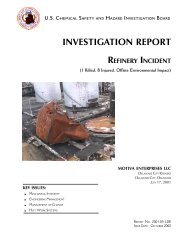Little General Store Propane Explosion - US Chemical Safety and ...
Little General Store Propane Explosion - US Chemical Safety and ...
Little General Store Propane Explosion - US Chemical Safety and ...
You also want an ePaper? Increase the reach of your titles
YUMPU automatically turns print PDFs into web optimized ePapers that Google loves.
<strong>Little</strong> <strong>General</strong> <strong>Store</strong> September 2008<br />
The CSB determined that the junior technician likely was unaware of the existence <strong>and</strong> function of the<br />
telltale due to inexperience <strong>and</strong> lack of training <strong>and</strong> removed the plug completely. Although the CSB<br />
determined that it is highly unlikely the telltale hole was obstructed at the time of the incident, CETP<br />
training could have made the junior technician aware of <strong>and</strong> prepared for the possibility of an obstruction<br />
of the telltale. The CETP section on liquid withdrawal valves states:<br />
In some cases, a damaged seat may allow an excessive amount of liquid to be discharged when<br />
the closing cap [plug] 24 is loosened. A bleed hole [telltale] in the closing cap has been provided<br />
to vent the liquid before the cap is completely unscrewed. If a significant amount of liquid<br />
continues to be blown from under the closing cap for more than 30 seconds, it can be assumed<br />
that the internal seat will not prevent a dangerous amount of gas from escaping. IF IN DOUBT,<br />
DO NOT REMOVE THE CLOSING CAP. [CETP 2.2.13]<br />
In addition to the information on the valve above, the CETP procedure for transferring liquid propane<br />
from a tank to a truck states: 25<br />
While removing the plug, if an excessive volume of propane leaks from the valve, reinstall the<br />
plug <strong>and</strong> follow manufacturer’s instructions. [CETP 2.2.13]<br />
The CSB initially tested <strong>and</strong> examined the tank <strong>and</strong> valve in its “as-found” condition. The CSB<br />
determined that the liquid withdrawal valve leaked when the tank was pressurized. 26 Following this<br />
examination <strong>and</strong> test, the CSB removed the valve from the tank, performed additional examinations <strong>and</strong><br />
24<br />
Plug (external threads) closures are no longer used with liquid withdrawal valves; therefore CETP refers only to<br />
cap (internal threads) closures.<br />
25<br />
CETP contains step-by-step procedures for liquid propane transfer from a stationary tank to a tank truck. Liquid<br />
propane transfer from a stationary tank to a second stationary tank is not described in CETP.<br />
26<br />
Nitrogen was used to pressurize the tank since it is inert <strong>and</strong> allowed this test to be conducted safely.<br />
28









